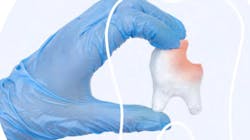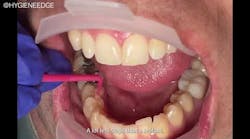Not using silver diamine fluoride regularly? Here's why you should be
Hygienists pride themselves on preventing disease and providing solid oral care education. When you’re thinking about caries prevention, I challenge you to give thought to what we can do differently and better in dentistry. The statistics for caries in pediatric patients are alarming. Fifty percent of patients ages 6–8 are affected by caries in their primary teeth, and 50% of children ages 12–19 are affected by caries in their permanent teeth.1 Children ages 5–19 from low income families are twice as likely to have caries in their young lives.2
Early childhood caries is still the number one childhood disease in the world. In 2022, The US Department of Health and Human Services reported that more than 51 million hours of school are missed each year because of dental problems.1 We must do better. Of the adult patients we treat, one-third report hypersensitivity, and one-fourth are likely to have untreated dental caries. Fifty percent of older adults suffer from root caries.3
Reasons to add SDF
The FDA approved silver diamine fluoride (SDF) for dentinal hypersensitivity in 2014. More than half the offices I’ve consulted for and worked with have purchased SDF, but the percentage of patients benefiting from SDF is less than 1%. SDF is used first to arrest decay, second to prevent decay, and last to decrease dentinal hypersensitivity. It’s a powerful tool to have in our daily armamentarium.
Reasons to add SDF to your daily routine are numerous:
- Silver destroys bacterial cells and interrupts cell synthesis.
- SDF has a fluoride concentration of 44,800 ppm. This is twice what’s in varnish.
- Fluoride creates fluorapatite, which is vital for remineralization.
- Fluoride is bacteriostatic.4
There are many benefits to using SDF for:
- Those with moderate to high caries risk
- Those who are behaviorally or medically challenged
- Patients without access to proper dental care
- Young children waiting for hospital-based treatment
- Noninvasive treatment for teeth close to exfoliation
- Dentinal hypersensitivity
- Biofilm control
- Fissure protection
- Treating root caries
- Patients with carious lesions that cannot all be treated in one visit4
The most current research supports the use of SDF, which is 89% more effective in controlling/arresting caries than other treatments or placebos.4 Annually, 38% of SDF applications to exposed root surfaces in older adults are a simple, inexpensive, and efficient way of preventing caries initiation and progression.4 When talking about minimally invasive procedures such as SDF, the goal is to present the clinically acceptable options and provide education so that the parent or patient can make the best decision for them.
More reasons to support SDF use
When SDF was applied only to carious lesions, impressive prevention was observed for other tooth surfaces. In both children and the elderly, an annual application of SDF prevented many more carious lesions than four-times-per-year fluoride varnish application.4 SDF has been proven to stop incipient lesions from needing restorative treatment.5 This begs the question—why aren’t dental practices treating incipient lesions with SDF?
Clinicians assume that parents will reject SDF for their children because of poor esthetics. But if it means a child doesn’t have to be sedated or have their tooth drilled and filled, many parents do choose SDF. Research shows that more than 90% of clinicians in a dental residency program believe that parental acceptance for SDF in a pediatric setting is a concern, when in reality they found less than 7% of parents were concerned with the staining.6
When submitting insurance, the CDT code to use is D1354, and it applies to treatment per tooth, not per application. The frequency of application depends on the risk factors and the size of the lesion. If you’re treating an incipient lesion, reapplication can be in six months. If the lesion is into the dentin, you may reapply in two to four weeks.
In offices that have SDF on hand but are not using it to its full capacity, the preventive care opportunity is subpar. Clinicians are concerned about stained teeth, countertops, and dental equipment, and they’re nervous to implement new protocols. Intact tooth structure does not stain.2
Research supports many patient situations where SDF is the best solution.
Examples for practical use of SDF
- A 90-year-old male presents with recurrent buccal decay on number 19 around the existing porcelain-fused-to-metal crown. He has a complex medical history and a high plaque index. Apply SDF to arrest the lesion and preserve the life span of the crown.
- Many interproximal lesions are present on the bite wing survey of an uncooperative 4-year-old patient. Use SDF to arrest decay until the patient can have definitive restorative work completed.
- Occlusal decay on number 30 is present in a 20-year-old healthy patient. Restorative schedules are booked out for three months. Use SDF to arrest the decay to keep the restoration conservative.
- SDF has become a standard of care in minimally invasive procedures. Its use can control the biofilm, arrest the progress, and remineralize lesions first. Then you may restore the teeth as time, resources, and money allow.5 When we’re thinking of reinventing and improving our standard of care in caries prevention strategies, think about what we can do differently, and what we can do better.
Editor's note: This article appeared in the November-December 2023 print edition of RDH magazine. Dental hygienists in North America are eligible for a complimentary print subscription. Sign up here.
References
- Oral health surveillance report, 2019. Centers for Disease Control and Prevention. Page last reviewed December 9, 2021. https://www.cdc.gov/oralhealth/publications/OHSR-2019-index.html
- Dye BA, Xianfen L, Beltrán-Aguilar ED. Selected oral health indicators in the United States 2005–2008. NCHS Data Brief. 2012;96(5):1-8.
- Chan AKY, Tamrakar M, Jiang CM, Lo ECM, Leung KCM, Chu CH. A systematic review on caries status of older adults. Int J Environ Res Public Health. 2021;18(20):10662. doi:10.3390/ijerph182010662
- Horst JA, Ellenikiotis H, Milgrom PL. UCSF protocol for caries arrest using silver diamine fluoride: rationale, indications and consent. J Calif Dent Assoc. 2016;44(1):16-28. PMID:26897901
- Braga MM, Mendes FM, De Benedetto MS, Imparato JC. Effect of silver diamine fluoride on incipient caries lesions in erupting permanent first molars: a pilot study. J Dent Child (Chic). 2009;76(1):28-33. PMID:19341576
- Crystal YO, Janal MN, Hamilton DS, Niederman R. Parental perceptions and acceptance of silver diamine fluoride staining. J Am Dent Assoc. 2017;148(7):510-518.e4. doi:10.1016/j.adaj.2017.03.013
About the Author

Brooke Ackerman, MSDH
Brooke is an expert in the dental field, an advocate for successful dental practices and high-quality, comprehensive patient care. She is a practicing clinical dental hygienist and holds a master’s degree in dental hygiene, with a focus on management through the University of Minnesota Carlson School of Business. Brooke is also a practice management consultant at Advanced Practice Management. You may contact her at (952) 921-3360 or through advancedpracticemanagement.com.

